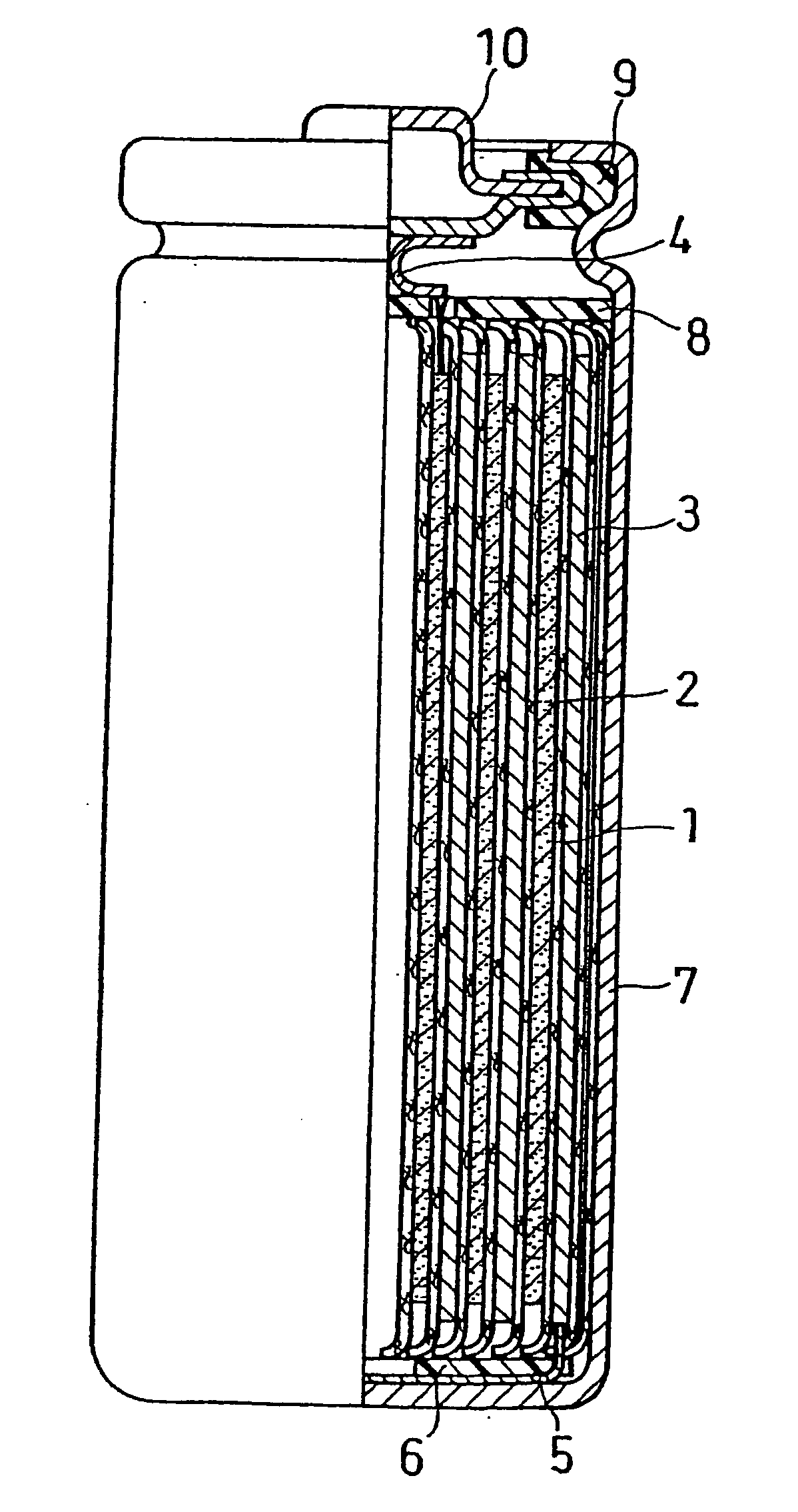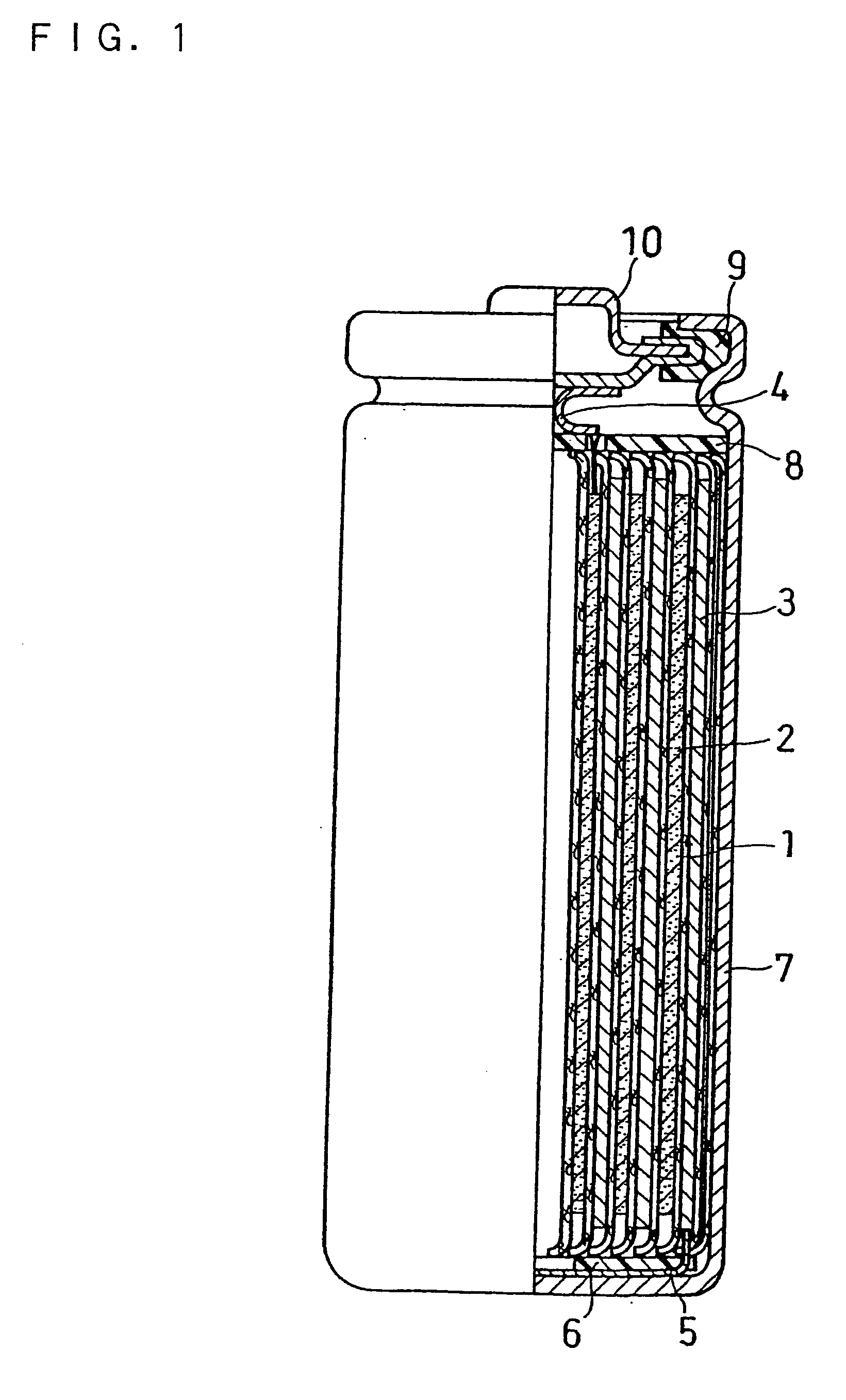Non-aqueous electrolyte secondary battery
a non-aqueous electrolyte, secondary battery technology, applied in the direction of secondary cell servicing/maintenance, non-aqueous electrolyte cells, final product manufacturing, etc., can solve the problems of reducing the service life of the battery. , to achieve the effect of preventing the temperature increase of the battery, high reliability, and small amount of gas generated inside the battery
- Summary
- Abstract
- Description
- Claims
- Application Information
AI Technical Summary
Benefits of technology
Problems solved by technology
Method used
Image
Examples
example 1 to 8
(i) Production of Positive Electrode
[0097] A mixture obtained by mixing Li2CO3, Co3O4 and MgCO3 at a molar ratio of Li:Co:Mg of 1:0.97:0.03 was baked at 900° C. for 10 hours to give a lithium containing transition metal oxide, namely, LiMg0.03Co0.97O2-δ (0≦δ≦1).
[0098] To 100 parts by weight of powders of LiMg0.03Co0.97O2-δ serving as a positive electrode active material were added 3 parts by weight of acetylene black serving as a conductive material, 7 parts by weight of an aqueous dispersion containing 40 wt % styrene-butadiene copolymer (BM-400B (trade name) available from Zeon Corporation, Japan) serving as a binder and an appropriate amount of an aqueous solution of carboxymethyl cellulose, which were then mixed to give a positive electrode material mixture paste.
[0099] The obtained positive electrode material mixture paste was applied onto both surfaces of a positive electrode current collector made of a 30 μm thick aluminum foil, which was then dried and rolled to give a p...
example 4
COMPARTIVE EXAMPLE 4
[0117] A battery was produced in the same manner as in EXAMPLE 1 except that, instead of decabromodiphenyl, hexabromobenzene was added to the non-aqueous electrolyte as a bromine compound.
[0118] The amount of hexabromobenzene contained in the non-aqueous electrolyte was 2 wt %. In other words, the concentration of bromine atoms contained in the non-aqueous electrolyte was 0.26 mol / L.
example 5
COMPARTIVE EXAMPLE 5
[0119] A battery was produced in the same manner as in EXAMPLE 1 except that, instead of decabromodiphenyl, hexabromocyclododecan was added to the non-aqueous electrolyte as a bromine compound.
[0120] The amount of hexabromocyclododecan contained in the non-aqueous electrolyte was 2 wt %. In other words, the concentration of bromine atoms contained in the non-aqueous electrolyte was 0.22 mol / L.
TABLE 1Brominecompound-CBrCW2Bromine compoundcontaining part(mol / L)CW1 (wt %)(wt %)Ex. 1decabromodiphenylNon-aqueous0.0010.008—electrolyteEx. 2decabromodiphenylNon-aqueous0.0030.024—electrolyteEx. 3decabromodiphenylNon-aqueous0.0050.039—electrolyteEx. 4decabromodiphenylNon-aqueous0.010.079—electrolyteEx. 5decabromodiphenylNon-aqueous0.030.236—electrolyteEx. 6decabromodiphenylNon-aqueous0.050.393—electrolyteEx. 7decabromodiphenylNon-aqueous0.10.786—electrolyteEx. 8decabromodiphenylNon-aqueous0.21.572—electrolyteComp. Ex. 1NoneNone00—Comp. Ex. 2decabromodiphenylPositive——0....
PUM
| Property | Measurement | Unit |
|---|---|---|
| temperature | aaaaa | aaaaa |
| constant voltage | aaaaa | aaaaa |
| temperature | aaaaa | aaaaa |
Abstract
Description
Claims
Application Information
 Login to View More
Login to View More - R&D
- Intellectual Property
- Life Sciences
- Materials
- Tech Scout
- Unparalleled Data Quality
- Higher Quality Content
- 60% Fewer Hallucinations
Browse by: Latest US Patents, China's latest patents, Technical Efficacy Thesaurus, Application Domain, Technology Topic, Popular Technical Reports.
© 2025 PatSnap. All rights reserved.Legal|Privacy policy|Modern Slavery Act Transparency Statement|Sitemap|About US| Contact US: help@patsnap.com



